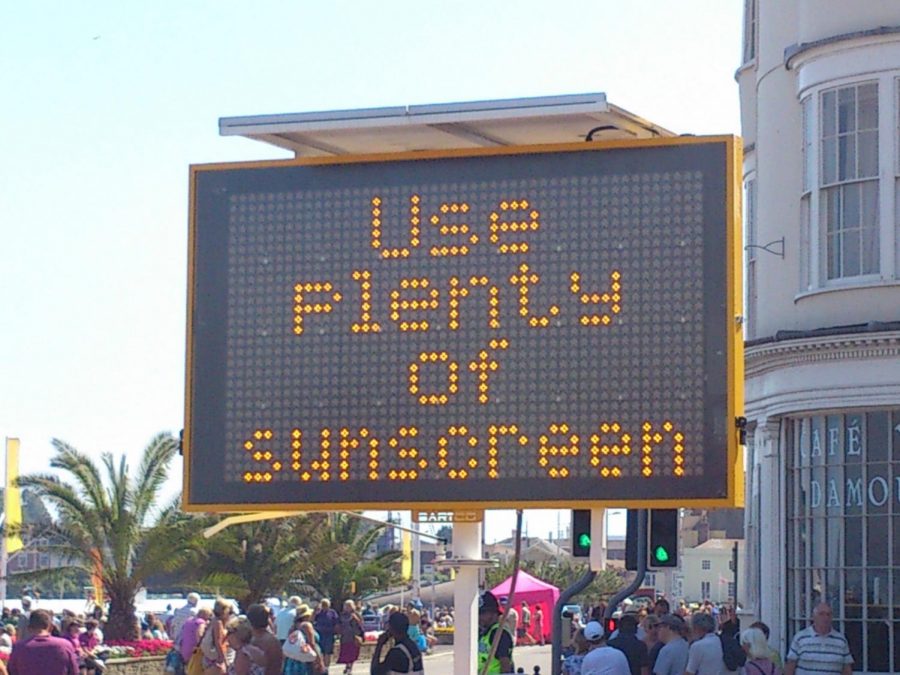Sunscreen protection still important, ingredients key to safety
A sign encouraging sunscreen use at beginning of a summer holiday
May 30, 2019
Skin cancer is the most common cancer in the United States.
According to the American Association of Dermatology, 9,500 people are diagnosed with skin cancer in the U.S. every day.
It is estimated that 20% of Americans will develop skin cancer during their lifetime.
It is also estimated that 11,650 people will die in our country from skin cancer this year.
Most cases of melanoma are attributed to exposure to ultraviolet radiation.
Reports have surfaced that assertions include everything from statements that sunscreen is ineffective to warnings that it’s outright dangerous.
There are sunscreens that can cause harm and statements that contain everything from sunscreen use if ineffective to actually dangerous. But according to a Harvard Healthy Publishing article titled, “The Science of Sunscreen” there is plenty of misinformation and people should be aware of the risks of over exposure to the sun and protect skin against it. Those who believe that sunscreen is more dangerous than overexposure to the sun need only reference the cancer statistics for reassurance when applying protective products to their skin.
Concerns over the safety of sunscreen products is certainly not unfounded. Studies have shown that certain chemicals which are commonly used in sunscreen can pass through the skin and enter the blood and organs of the user.
With the summer season and summer holidays approaching Northeast Valley News wanted to take a look at sunscreen safety and the available options for protecting against skin cancer.
The Environmental Working Group (EWG) has done exhaustive research on hundreds of sunscreen products, their ingredients and the possible effects they may have on our bodies and other organisms around us. The organization is considered to be a leader in sunscreen research.
There are two types of commercially available sunscreens — chemical and mineral.
Mineral sunscreens are generally considered safer than chemical sunscreens. They use finely ground particles of zinc oxide and titanium dioxide to reflect the sun. They are also safer for the environment, according to EWG, specifically for coral reefs.
Mineral sunscreens are almost always lotion-type products. They are sometimes difficult to apply and can leave behind a chalky, white, residue. Unfortunately, they are also generally less effective and less waterproof than chemical-based products so can be sweated or washed off more easily.
Chemical sunscreens are products which act to absorb the sun’s harmful rays before they get to your skin. They are the most effective types of sunscreen and come in lotion or aerosol varieties. They commonly use a combination of chemicals including oxybenzone, avobenzone, octisalate, octocrylene, homosalate and octinoxate. They are easy to apply, but sometimes the chemicals can cause skin irritation. This reporter actually had an allergic reaction to octocrylene on this past spring.
According to the EWG and others, the primary concern with sunscreen safety is with the chemical, oxybenzone. It has been found to more easily pass through the skin and enter the blood and breast milk of humans. It has also been determined to act as a hormone inhibitor, disrupting the formation of key hormones like estrogen and testosterone in lab animals.
Even though the effects of oxybenzone on humans is unknown, EWG recommends children and pregnant or breastfeeding woman not use products which contain oxybenzone.
Luckily, oxybenzone is being used in fewer and fewer products and has been banned in places like Hawaii because of the harm it reportedly does to coral reefs.
Another concerning chemical, according to EWG, is retinyl palmitate. It’s basically vitamin A and it generally acts as an anti-aging agent. The trouble is, when applied to the skin and exposed to ultraviolet rays, retinyl palmitate has been shown to actually speed up the growth of cancer cells in government tests. It may also lead to birth defects, so shouldn’t be used by pregnant women.
SpotSkinCancer.org and EWG both agree that people can reduce their risk of skin cancer by seeking shade, wearing a wide brimmed hat and protective clothing as well as sunglasses. They also advise being active outdoors during the morning and evening hours when the sun’s rays are less direct and using a sunscreen product that is appropriate for you.


